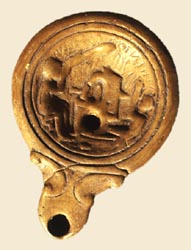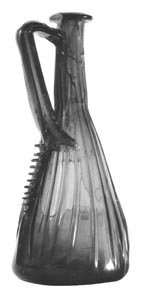|
Innovation and Practice
For the Jerusalem
glassblower, the blow pipe was the glass tube itself. Around
50 B.C., however, the use of a separate blowpipe was introduced.
The source of this inspiration is uncertain. Most likely,
someone took the kind of clay pipe then being used with bellows
to drive extra air into iron-smelting furnaces, gathered up
a hot chunk of glass on its nozzle, and blew from the other
end. The iron blow-pipe of the kind used today was surely
introduced only a few years later.
The blow pipe's invention
had far-reaching consequences. It allowed the craftsman to
gather a sizeable chunk of hot glass from a small furnace
and expand it into larger, sometimes more complex forms. Many
changes in the glassworkers' repertoire soon followed. Casting
could be used only for glass vessels with an open form-platters,
bowls, and cups-whereas free-blowing could be used both for
those and for vessels with a closed form, such as the narrow-necked
jugs, bottles, and food storage jars which previously had
been the marketplace prerogative of pottery-makers.
For examples of later free-blown vessels, see
4th
Century A.D. Tablewares.
|
|
 Pottery lamp
Depiction of glassblower's furnace
Early 1st century A.D.
From Split, on the Adriatic coast
 Conical jug
Ht., 28.3 cm
Mid-to-late 1st century A.D.
From Radnage, England |

